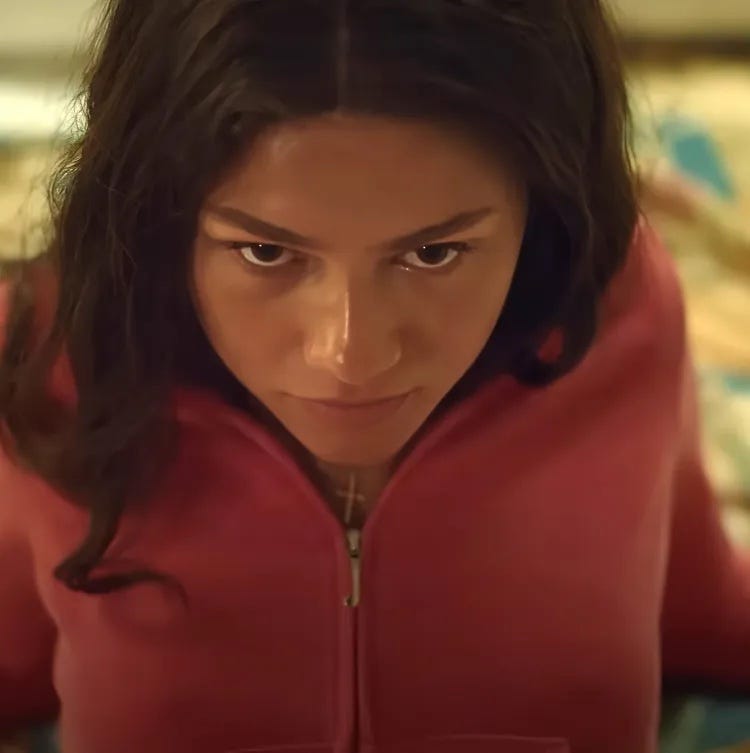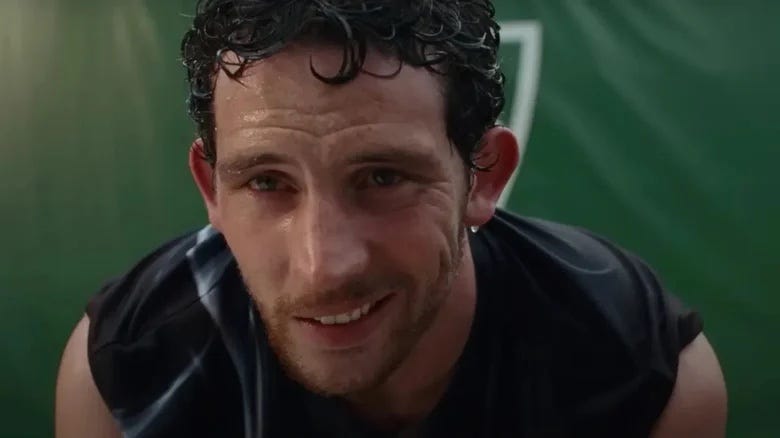“You don’t know what tennis is. It’s a relationship. For about 15 seconds there we were actually playing tennis, and we understood each other completely. So did everyone watching. It was like we were in love, or like we didn’t exist. We went somewhere really beautiful together.”
- Tashi Duncan
“Come play with me
It's about to get freaky
Bring your hips to life
So what are you waiting for? (It's your serve)
Won't you come on over? (The ball's in your court)
If it's one on one, if it's two on two
I wanna play wet tennis all night with you”
-Sofi Tukker
“Any triangle is a love triangle if you love triangles.”
-Pythagoras
I have a habit of choosing oddly masochistic movies to watch on planes.
Saw X was my worst pick, followed closely by a Spanish dub of Oppenheimer. Turns out that my Spanish, while fluent in bars, restaurants, and taxis, struggles with particle physics.
But Challengers came close.
I imagine my neighbor watching me watch Challengers felt just as disoriented as I did—like watching Remember the Titans if the team seduced each other between slow-motion touchdowns.
The cinematography alone was dizzying. At one point, the camera was affixed to the players’ rackets like a GoPro. Then it plunged below the court for a subterranean view, and finally, it became the ball, bouncing with frenetic energy and dizzying spin between the sweaty protagonists.
The hyperactive style, impressive at first, overstayed its welcome. Like an NFL game, the final two minutes of play stretched into eternity, leaving me as exhausted as the players.
The final point was shot almost entirely in slow motion. Coupled with Trent Reznor and Atticus Ross’s manic techno score, it had me wanting to scream, like Tashi: “COME ON!”
I suspect I wasn’t the only one who reached the end credits and muttered “huh?” out loud.
This film defies your expectations.
It’s not the steamy erotic thriller the marketing promised, not a clean sports metaphor other directors might settle for, and certainly not a “let’s watch Zendaya be beautiful” romp for mass audiences.
Then I rewatched it and realized how much I’d gotten hung up on the film’s text, missing the subtext entirely.
Yes, everyone’s unhappy and horny—especially the two handsome, yet undeniably rodent-like, male leads.
But this film is about much more than “wow, those rat boys are thirsty for eachother,” despite what the homoerotic churro-eating sequence might have you believe. In keeping with the film’s commitment to provocative triads, here are three opposing yet equally valid takes on what it’s really about. In true Challengers fashion, these interpretations aren’t mutually exclusive—their tension is the point.
Challengers isn’t about tennis; it’s about the shifting power dynamics in a love triangle
Watching this feels like reading John McPhee’s Levels of the Game—if Clark Graebner and Arthur Ashe had a lot of sexual tension.
But why tennis?
On a surface level, the grunting and sweating act as a crude proxy for sex. Director Luca Guadagnino said he chose tennis because it’s an intimate 1 on 1 sport where the opponents never touch. Tennis thrives on chemistry, friction, and heat between players. The best matches are between equals with complementary strengths and vulnerabilities.
The push and pull, the need to outmaneuver, and the tense balance of power in each rally mirror the dynamics of a love triangle, where every move carries weight. Tennis, like relationships, is about pursuit, strategy, and knowing when to strike. As Art (Mike Faist) smugly and sweatily says in a sauna to Patrick (Josh O’Connor): “Tennis is about winning the points that matter.”
This is a movie about desire, power, and longing, where tennis becomes a stand-in for sex.
As Zosha Millman writes in Polygon
Over and over, director Luca Guadagnino and writer Justin Kuritzkes interrupt sex with tennis, and have tennis take on the affectations of sex. What happens in one tends to say something about the other.
This sizzling premise drew plenty of press and hype.
The iconic image of Tashi (Zendaya) smirking as Patrick and Art kiss her, then each other, became the defining moment for some viewers. Yet after this, the film defies expectations even further. Those hoping for more steamy scenes will find themselves edged by Tashi, just like Art and Patrick
So why does such a horny movie show so little sex?
Like everything else in Challengers, this is deliberate.
Challengers isn’t about a bisexual love triangle—it’s about tennis as a metaphor for the cost of chasing dreams.
In terms of screentime, there’s far more tennis than kissing—let alone sex.
So what does all the tennis express that the missing sex can’t?
Tennis on screen can say a lot.
In Bridesmaids, the heated yet silly tennis match between Rose Byrne and Kristen Wiig serves as a proxy for their budding rivalry, with Byrne’s stepkids famously remarking, “I’ve seen better tennis in a tampon commercial.”
Determined to avoid that critique, Guadagnino hired Brad Gilbert—who coached Andre Agassi and Andy Roddick—to consult on the tennis. Gilbert collaborated with the screenwriters on tennis choreography and trained the actors on how to hit and move on the court. The tennis scenes reflect the film’s attention to detail—like Anna Mueller, the player Tashi easily defeats early on, later becoming a top female player. It’s a haunting “what if” for Duncan.
These details matter—they give the plot emotional weight and impact.
Challengers is a tennis movie in the same way Whiplash is a drumming movie. It uses the mechanics and drama of an intense subculture to tell a much bigger, deeper story. Both films explore the cost of chasing excellence.
Oddly, the film that came to mind for comparison was Wes Anderson’s breakout family drama, The Royal Tenenbaums.
Like Anderson, Guadagnino uses hyper-stylized filmmaking to explore a universal fear—that we may never achieve the glory we felt destined for as children.
This fear echoes in the bleak emotional state of all three protagonists. Though they showed tremendous promise as youth tennis players, here’s where they land as adults:
Tashi’s injury cruelly strips her of purpose and greatness, leaving her as Art’s coach and wife—a financially stable but soulless, sexless existence.
Art finds financial and athletic success as a pro, but turning his passion into a career extinguishes the joy it once brought him.
Patrick turns pro but never breaks through, stuck on the sport’s fringes without fame, fortune, or love—despite his undeniable skill and charisma.
All three wind up equally miserable, though in very different ways.
So, what are they missing?
Why can’t anyone in this movie just be a happy, horny tennis player?
This, dear reader, is the innermost layer of Guadagnino’s game—the real question he’s asking.
Challengers isn’t about tennis or a love triangle—it’s about the messy intersection of wanting, needing, and lacking in adult life.
The tennis, like the love triangle, is just a means to an end.
Like Tár, this movie uses a labyrinthine world to explore deeper questions about power, legacy, and what it takes to be on top.
Just as the takeaway of Tár isn’t “wow, classical music sure is complicated,” the “look, bisexual tennis players in a love triangle!” commentary on Challengers misses the point.
The most compelling way to view Challengers is as a character study of three uniquely broken people, each struggling to figure out the difference between what they want and what they need to feel alive.
Zendaya nailed it when she called it “Codependency, The Movie.”
By the end, they all face the messy truth: they need each other to feel whole.
The love triangle isn’t about gawking at sweaty bisexual tennis players—it’s about viscerally experiencing, and maybe even empathizing with, the interconnectedness of their predicament.
They’re drawn to each other over a lifetime of sex, lies, and tennis because each one has something the others lack.
As one Redditor succinctly put it:
Art has skill and structure but no passion.
Patrick has skill and passion but no structure.
Tashi has structure and passion but no skill (post injury).
It’s a 3-circle venn diagram and the last scene is when all three circles overlap and everyone finds, at least for a moment, what they really need.
Guadagnino’s real curiosity lies in what drives us.
He’s fascinated by how lust and anger act as intense motivators—hence the overlap in the metaphors we use to describe them
Phrases like “losing your fire” or “getting your mojo back” capture that elusive motivation we need to be our fullest selves.
Patrick and Tashi’s prodding—and, at times, manipulation—are exactly what Art needs to reignite his fire.
Like an epic tennis rally, the movie serves as a fascinating study of the adversity it takes to bring out our best performances.
Like Netflix’s Beef, this film explores how people thrive in opposition—sometimes what we’re missing isn’t a lover or a friend, but an antagonist.
Where Richie Tenenbaum needed family reconciliation and emotional closure, Art needed his Bridesmaids moment—Melissa McCarthy storming in and demanding he fight for his messy life.
In a world of mostly soulless cash grabs, endless franchises no one asked for, uncanny valley CGI remakes of childhood classics, and Robert Zemeckis’s latest quixotic cinematic obsession, I’ve come to savor challenging movies like this one. I admire their complexity and finesse just as much as their fearlessness and unapologetic identity. Like any good sport, there’s a learning curve to fully enjoy them— but the replay value is so much higher.







